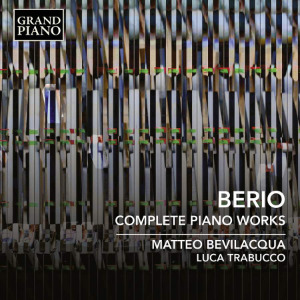
Luciano Berio (1925-2003)
Complete Piano Music
Matteo Bevilacqua (piano), Luca Trabucco (piano, Canzonetta and Touch)
rec. 2022, Luke Recording Studio, Cividale, Friuli, Italy
Grand Piano GP903 [74]
In 2007, Andrea Lucchesini recorded most of Berio’s piano music (review). He had the immediate advantage of having worked on this music with Berio in the 1990s; they are pictured together of the booklet cover. This disc adds the five movement Petite Suite of 1947. I wrote then: ‘Berio’s music has not faded from the limelight’. I feel this is no longer true, especially in live performances. All the more reason to welcome this newcomer.
What differences are there in how these two fine virtuosi perform Berio? Take Sequenza IV. I am a little torn. Lucchesini plays in a more exciting, brilliant way, and a minute faster – at eleven minutes – than Bevilacqua. The latter’s reading, not surprisingly, is more relaxed, less flashy and more reflective. Bevilacqua also uses the third pedal, producing a sort of random hidden melody. I also prefer the recording.
I have a soft spot for the Six Encores. Written over a twenty-six-year period, they are stylistically quite contrasted, but meld together successfully. Again, Bevilacqua takes his time. Entirely appropriately, he brings out a feeling of dreamy impressionism in three encores, for example Erdenklavier (earth piano).
The Petite suite gets its first recording. The movement are Prélude, Petit Air I, Gavotte, Petit Air II and Gigue, but this is not really a neo-classical work. As Ivan Moody says in his notes, it is Bach re-imagined through the lens of Prokofiev. The piece is often witty, vibrant and most enjoyable. This recording may help it find a secure way into the general repertoire.
In the early 1950s, many composers became deeply fascinated by Webern’s aphoristic music and obsessed by serial technique. Cinque variazioni, from that period, are dedicated to another dodecaphonist Luigi Dallapiccola. The two composers developed serial technique in their own ways, by repeating patterns as in the closing bars of this work, or by contriving the lines to be more lyrical. In its compact eight minutes or so, the piece combines static moments and brilliant toccata-like figuration, always creating a tension between them and holding one’s attention. This is a captivating performance but such music seems quite out of fashion nowadays. This also applies to Rounds, perhaps the most pointillistic work of the set, a sort of half-way house between Webern and Stockhausen’s Klaverierstücke. Berio adapted it from the original version for harpsichord.
The Sonata’s first six minutes obsess on the note B flat, and arguably throughout like a ground bass. It is decorated with flashes of colour across the keyboard. Andrea Lucchesini premiered it in 2001. I wrote in my review tha the work ‘brilliantly sustains a single concept over its extensive span’ of twenty-three minutes. Bevilacqua gives a thrilling and sparkling interpretation, but I suspect that he has learned a little something from Lucchesini: he enables the more dreamy qualities to come to the fore where necessary. There is a gripping drama here which holds the attention.
Two four-hand duets, Canzonetta and Touch, cap the programme. They are small in duration but large in scope. Luca Trabucco is Bevilacqua’s very able partner.
I like the older Avie disc for its extensive booklet notes. There are Berio’s personal reflections on the Piano Sonata, an essay by Lucchesini and a longer, more wide-ranging one by David Osmond-Smith. That is not to disparage the quite detailed documentation on this new release, with Ivan Moody’s very perceptive essay and descriptions of the music.
Gary Higginson
Help us financially by purchasing from



Contents
1-5. Petite Suite (1947)
6-11. Six Encores (1965-1990)
12. Sequenza IV (1966)
13. Canzonetta for piano four hands (1991)
14. Touch for piano four hands (1991)
15. Cinque variazioni (1952-1953, rev. 1966)
16. Rounds (1964-1965, version for piano 1967)
17. Piano Sonata (2001)


















